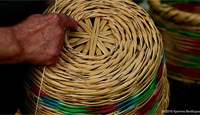
Applicants
Livadia Municipality,
Cyprus Architectural Heritage Organisation, Akrotiri Community Council, Akrotiri Environmental Education Centre
Communities Concerned – Bearers of the element:
Livadia Municipality, basket-weaving craftsmen
Cyprus Architectural Heritage Organisation, Akrotiri Community Council, Akrotiri Environmental Education Centre
Domain of Intangible Cultural Heritage:
Traditional craftsmanship
Date of inscription:
2015, 2016, 2017
Geographical location and range of the element:
Basket-weaving with the use of wicker or reeds has been practised in Cyprus as a professional activity in the Mesogi, Liopetri and Livadia communities. Up until 1985 there were also other communities that were involved in basket-weaving, such as: Astromeritis, Pano Lakatamia, Akrotiri, and Kaminaria. The Livadia community has been practising this craft already since the 19th century and the Municipality is actively promoting the protection of this traditional craft.
Brief Description:
Basketry / straw-mat making is a craftsmanship which has changed very little with the passage of time and is still being practised today. There are very few tools required and the raw material is reed, wicker or straw. Different types of baskets can be made such as the large “kofina”, or woven baskets used for the collection and transportation of agricultural produce, the linen baskets and the baskets used by the fishermen. Moreover, the so-called “kalamotes” and “psatharkes” were made, which are coarse woven straw-mats used mainly as interior claddings in roof restorations of old houses or also used for shading or fencing.
According to witness accounts, it is estimated that the inhabitants of Livadia began to weave baskets during the 19th century, as the articles made were particularly useful for their daily lives. Although this started as a male professional activity, it was gradually transferred to the women as men preferred to become employed as labourers and craftsmen thus securing a double income for their families.
Basket-weaving / straw-mat making gradually became a social activity as it was often carried out collectively, in courtyards or under the shade of trees. This is where the villagers would discuss the village news, develop interpersonal relationships, sing together, and spend their time together, thus making their workplace a place for leisure and socialising.